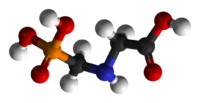
Photo from wikipedia
Glyphosate‐based herbicides (GBHs) are a group of widely used broad‐spectrum agricultural pesticides. Due to the recalcitrance of GBH, it has been found in food and environment as a contaminant, posing… Click to show full abstract
Glyphosate‐based herbicides (GBHs) are a group of widely used broad‐spectrum agricultural pesticides. Due to the recalcitrance of GBH, it has been found in food and environment as a contaminant, posing a threat to public health. The health risks associated with GBH have been indicated by reporting acute toxicity data (an acute exposure of GBH at a 0.5% dose), which primarily discuss toxicity in relation to accidental high‐rate exposure. Currently, there is little information regarding the toxicity of GBH at environmentally relevant levels. In this study, we used mature mouse oocytes to study the toxic effects of low‐dose GBH exposure in vitro (0.00001%–0.00025%) and in vivo (0.0005%, orally administered through daily drinking water) during meiotic maturation. GBH exposure led to meiotic maturation failure with spindle defects and chromosome misalignment. In addition, GBH treatment severely reduced sperm‐binding ability and disrupted early embryo cleavage. Moreover, GBH exposure significantly increased the reactive oxygen species (ROS) levels and apoptotic rates. Evidence indicates that such effects in GBH‐exposed oocytes are likely due to overexpression of the G‐protein estrogen receptor (GPER/GPR30). Remarkably, we found that melatonin administration elicited significant protection against GBH‐induced oocyte deterioration via preserving the expression of GPR30, along with activation of its downstream signaling event (pERK/ERK). Taken together, these results revealed that low‐dose glyphosate has a certain adverse effect on oocyte maturation and early embryo cleavage, and highlight the protective roles of melatonin.
Journal Title: Journal of Pineal Research
Year Published: 2021
Link to full text (if available)
Share on Social Media: Sign Up to like & get
recommendations!